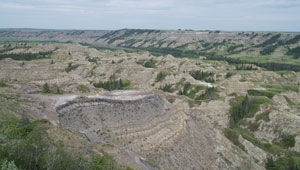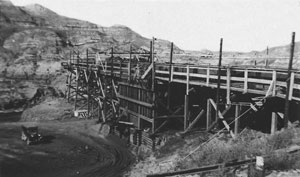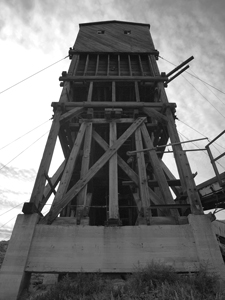
Some might say that Drumheller came into existence in 1916 when it was officially named a town. Others might say it began with the mines, or with the farmers and ranchers who settled in the valley.
Look to the walls of the valley and there is a deeper history written in the rocks themselves and far more is told in the rocks that lie below the ground.
If we rewind the clock back to 4.6 billion years ago, things were quite different. It was an Earth that resembled something more like Dante’s Inferno.
Volcanoes spewed out lava that would cool and form the granite terrain of Alberta, which in turn would be eroded and deposited into the nearby coast, which would have been roughly where the Rocky Mountains are today.
The Earth may have mostly been a hellish landscape, but it was also a time of huge extremes. Roughly 750 to 580 million years ago the Earth may have undergone four ice ages. The entire surface of the planet, Drumheller included, was entirely covered by kilometre-thick ice in a condition known as Snowball Earth.
When the climate warmed up again the nearby ocean slowly crept inland. By 490 million years ago Drumheller was under a shallow sea.
The sea retreated briefly at the beginning of the Devonian Period (418 million years ago), eroding the rocks laid down earlier. After 10 million years the sea returned. Reefs grew in the warm, shallow waters.
Drumheller and many other areas in Alberta rely on these ancient reefs today. The Devonian reefs and the organisms that lived in them would eventually become the fuel that drives industry in Alberta: petroleum.
The sea gradually fell back, and after 100 million years Drumheller was once again dry land. Drumheller was on the coast of the continent Laurasia (composed of North America, Europe, and Asia), and eventually the super continent Pangaea.
The plants and animals that inhabited Drumheller would have looked alien in comparison to today. Giant ferns, horsetails, and other now-extinct trees would have dominated the area. Large insects, such as dragonflies, amphibians, and reptiles would have prowled the vegetation.
With every continent glued together, the climate became much drier. Drumheller would have suffered under long dry seasons, punctuated by monsoons and the occasional storm coming off the ocean.
Pangaea began to break apart by the end of the Triassic (205 million years ago) and finished during the Jurassic. The climate became wetter, allowing Drumheller to be covered in extensive swamps and forests.
Dinosaurs would have been quite conspicuous at this time, such as huge long-necked dinosaurs. Other animals, such as small mammals, would have scurried about as well.
The Jurassic saw the rise of the Rocky Mountains as well. British Columbia collided with the west coast of Canada and rocks that had previously been under the ocean, or buried deep within the ground were thrust upward.
Up to this point all of the rocks that tell this story are buried beneath the surface. This is where the Cretaceous aged rocks that line the Drumheller Valley come in.
The burgeoning Rocky Mountains caused the lands to the east to sink, allowing the formation of a sea that stretched from the Arctic Ocean to the Gulf of Mexico.
For most of the Cretaceous, Drumheller was sandwiched between the mountains to the west and the sea to the east. Large rivers ran through the area, and Drumheller would have been part of a large coastal plain and would have resembled Florida.
The layers of rock lining the valley were laid down by the massive rivers that meandered throughout the land. The rivers carried tonnes of sediment that was shedding off the Rocky Mountains, making an ideal environment to entomb the dinosaurs and other animals that perished.
Extensive wetlands were present at this time. When buried by sediment from rivers, the decaying vegetation would form the layers of coal that fueled the growth of the towns that would later inhabit the area.
The climate remained warm and humid. Hurricanes and storms would have occasionally battered the area, flooding the land and killing many animals, which accounts for many of the fossils found in the area.
Forests and swamps contained conifers, ferns, and the relatively new flowering plants. Vast herds of horned and duckbilled dinosaurs wander the land, hunted by ferocious predators such as Albertasaurus.
The sea that covered parts of North America at one point grew to cover Drumheller. The rocks that were deposited at this time form the base of the hoodoos near East Coulee.
The waters were filled with ammonites and large marine reptiles, such as mosasaurs and plesiosaurs.
The sea drained from North America by the end of the Cretaceous and things came crashing to an end. A combination of volcanoes and a large asteroid impact finished the dinosaurs and many other animals alive at the time.
Things were briefly quite dire, but soon the warm temperatures and heavy rainfall that characterized Drumheller in the Age of Dinosaurs returned. Forests of conifers and broad leaved trees dominated the area, with rivers, lakes, marshes, and plains dotting the land.
Without the dinosaurs around, mammals began to flourish, although many did not initially resemble what we see today.
The climate gradually became cooler and drier. The Rocky Mountains prevented moisture from the Pacific Ocean reaching the lands to the east. The result was that the forests covering Drumheller gave way to grass covered plains.
Two million years ago the planet started experiencing repeated ice ages. Drumheller was repeatedly covered in glaciers that were nearly a kilometre in height and that extended down into the United States.
The glaciers scoured the land and formed many of the topographical features we see today.
The hilly terrain north of Drumheller, towards Stettler is the result of water flowing underneath the glacier. The large boulders that can be found on the prairies were carried by the glaciers from the mountains and dropped off on the prairies.
The last glaciers retreated 10,000 years ago. As they were melting, the glaciers would form large lakes in front of them, dammed by ice and rubble. When the lakes would burst their dams the resulting torrents would carve out huge valleys.
The Red Deer River valley is thought to have formed when the lake covering Red Deer was released.
Over the millennia since the valley formed, the elements have slowly eroded the edges of the valley and exposed the natural treasures that lie beneath the prairies, encouraging the growth of the mines and palaeontology.
The valley itself is relatively young, but the area has undergone tremendous transformations over the life of the planet. Drumheller has been a fiery inferno, a serene sea, to tropical oceanfront property, and winter may be coming, but at least we’re not under a glacier anymore.
























